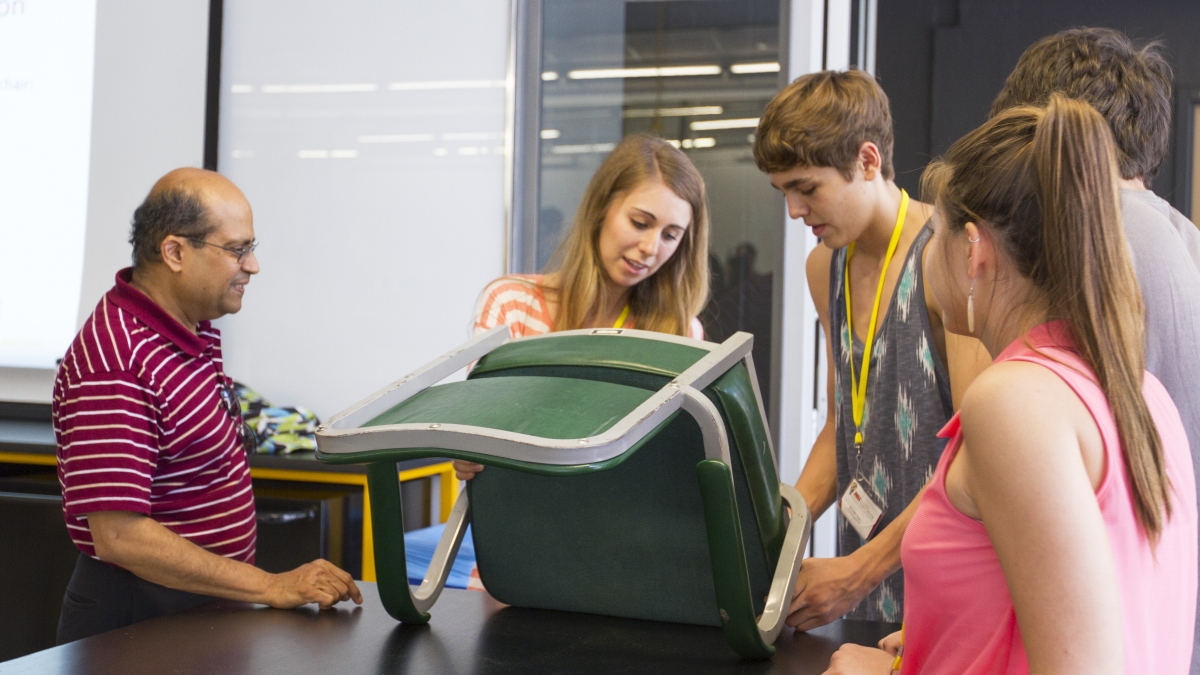Ramakrishna tapped to lead Grand Challenge Scholars Program's growth

B.L. Ramakrishna (left) served as director of the Grand Challenge Scholars Program at ASU from 2009 to 2013. Now, he's overseeing the program on a national level. Photo by: Jessica Hochreiter/ASU
An Arizona State University faculty member has taken on a recently created leadership position within the National Academy of Engineering.
Emeritus professor B.L. Ramakrishna was named director of the Academy’s Grand Challenges Scholars Program Network.
Proctor Reid, NAE’s director of programs, said this position was designed to “facilitate the development and expansion” of the Grand Challenge Scholars Program, which he describes as a “powerful educational movement.”
The undergraduate education program was established in 2009 with a focus on preparing students to contribute to solving some of the biggest challenges of the 21st century.
The program is now active in 38 universities across the United States, and in four universities abroad. As director, Ramakrishna will focus on the continued growth of the Grand Challenge Scholars Program, as well as improving the programs nationwide through data collection, research, community building efforts, outreach and partner development.
ASU program opens doors
Ramakrishna brought the program to ASU’s Ira A. Fulton Schools of Engineering in 2009. Serving as the director until 2013, he established the program as the Fulton Schools’ Scholar Academy, a unique, application-based program for highly qualified engineering students.
In 2013, the Fulton Schools’ program produced its first graduate from among 60 students and has since grown to 480 students, 31 percent of which are female.
Ramakrishna was driven to support and expand the program because it reflected his commitment to creating future engineers who have an interdisciplinary education, an entrepreneurial mindset, a global perspective and a deep sense of social consciousness.
He said ASU’s program offered a pivotal insight into the growth potential of the program on a national level. Prior to founding the program at ASU, Grand Challenge Scholar Programs were in place at only a handful of private universities.
“When we established a successful program at a university like ASU, it proved that this program can be grown across public and private universities — both large and small,” Ramakrishna said.
In 2013, Ramakrishna stepped down as director to accept a prestigious Jefferson Science Fellowship, which brought together a team of four doctors, four scientists and four engineers to advise the U.S. State Department in foreign relations through the lens of science, engineering and health.
“This experience really helped me to understand the big picture impacts of a program like this,” Ramakrishna said.
“I saw how science and technology and innovation can come together to transform global development and inform foreign policy,” he said.
In his role in the Jefferson Science Fellowship, Ramakrishna traveled to several countries, including Tanzania, Ghana, Armenia and India. He made connections on his diplomatic visits that should help him advance the National Academy of Engineering’s goal to scale the Grand Challenge Scholars Program globally.
Prior to this fellowship, Ramakrishna was a faculty member at ASU for more than 30 years.
Leading a movement
After seven years of organic growth, Ramakrishna has a five-year goal to swiftly expand the program to 150 universities across the United States, and to 75 universities abroad.
Throughout the growth process he will continue to champion the locally-driven nature of the program.
“We leave the implementation of the program to the specific institution and encourage individual approaches to suit each university and their community,” he said.
The National Academy of Engineering supports this program because it “promotes what engineering is really all about,” Ramakrishna said.
“The program captures the vision that engineering is a mechanism for creating solutions to problems our people and planet face and as a result makes the world more sustainable, healthy, secure and joyful,” he said.
Ramakrishna said playing a role in communicating that vision to students across the country and around the world is what really excites him.
In addition to capturing the hearts and minds of young engineers, Ramakrishna’s aims to increase support for this program’s movement across industry, universities, governments, NGOs and professional engineering societies.
Currently, the program primarily depends on mentors in academia, but Ramakrishna has a vision that includes attracting more professional engineers to the effort.
“I believe engineering professionals recognize there’s a demand for the type of engineers that this program produces in their companies,” Ramakrishna said.
“Industry demands engineers that have technical depth, but also interdisciplinary breadth. Companies want employees who know how to think economically, ethically, culturally and globally,” he said.
“For the National Academy of Engineering, the Grand Challenge Scholars Program is really more of a movement than a project,” he said.
And he expects the vision of the program to continue to grow and transform the world, saying, “I’m not afraid to think big and really long-term. Even into how this program will grow to someday propel engineers to meet the challenges of not only the 21st century, but into the 22nd century and beyond.”
More Science and technology

Associate professor shares her journey from NASA to ASU
From leading space missions to designing and building spaceflight hardware and training students in space science and engineering…

Famed systems engineer inspires ASU to tackle global problems
“Providing great talent with great opportunity can make a great difference.” Such was a key part of the message delivered by G.…

The science behind chronic stress
Stress comes in many shapes and sizes. There’s the everyday stress of preparing for a final exam or being stuck in traffic. And…